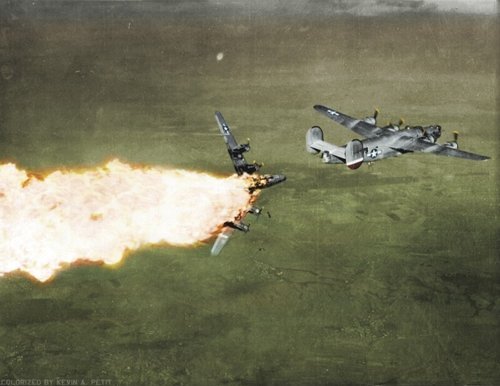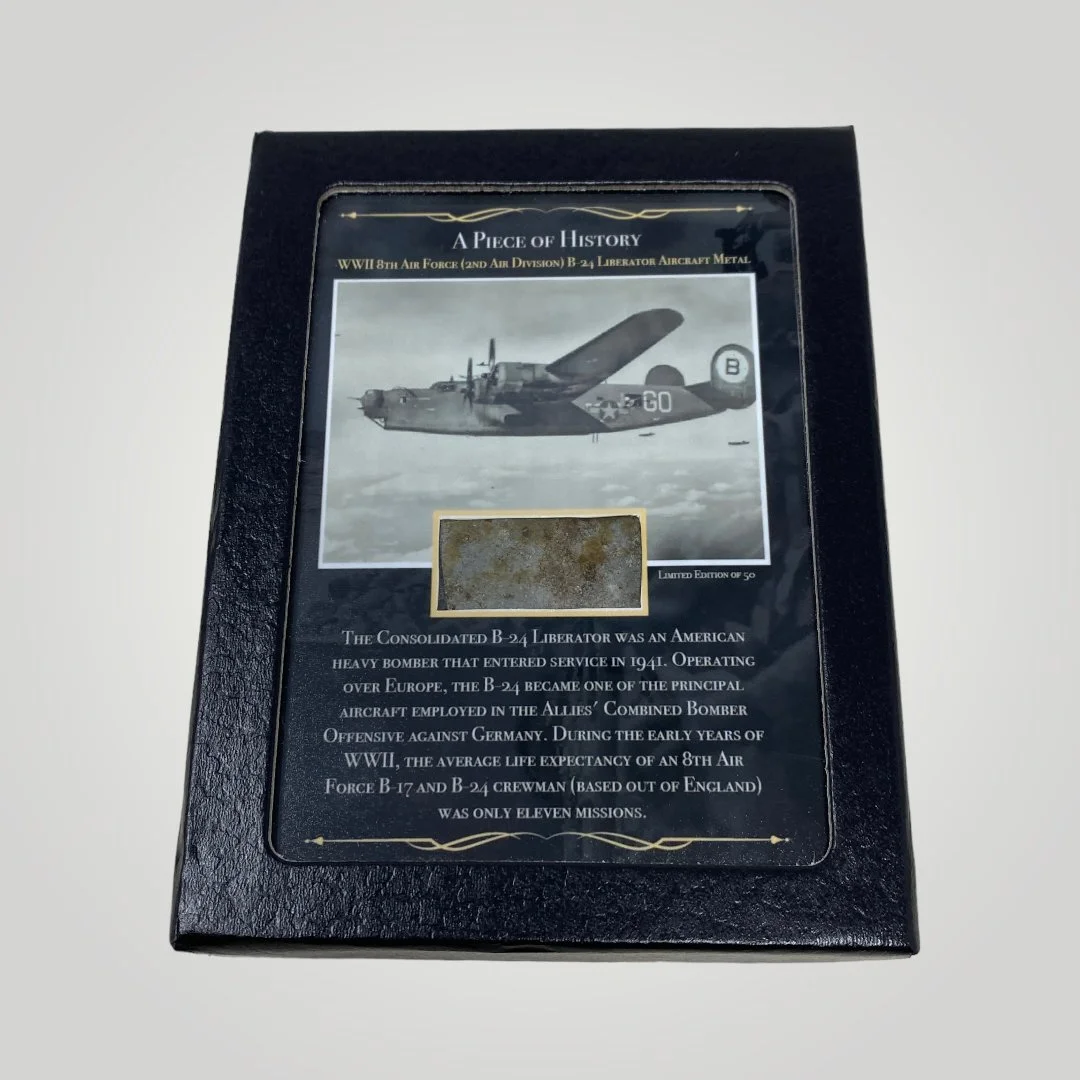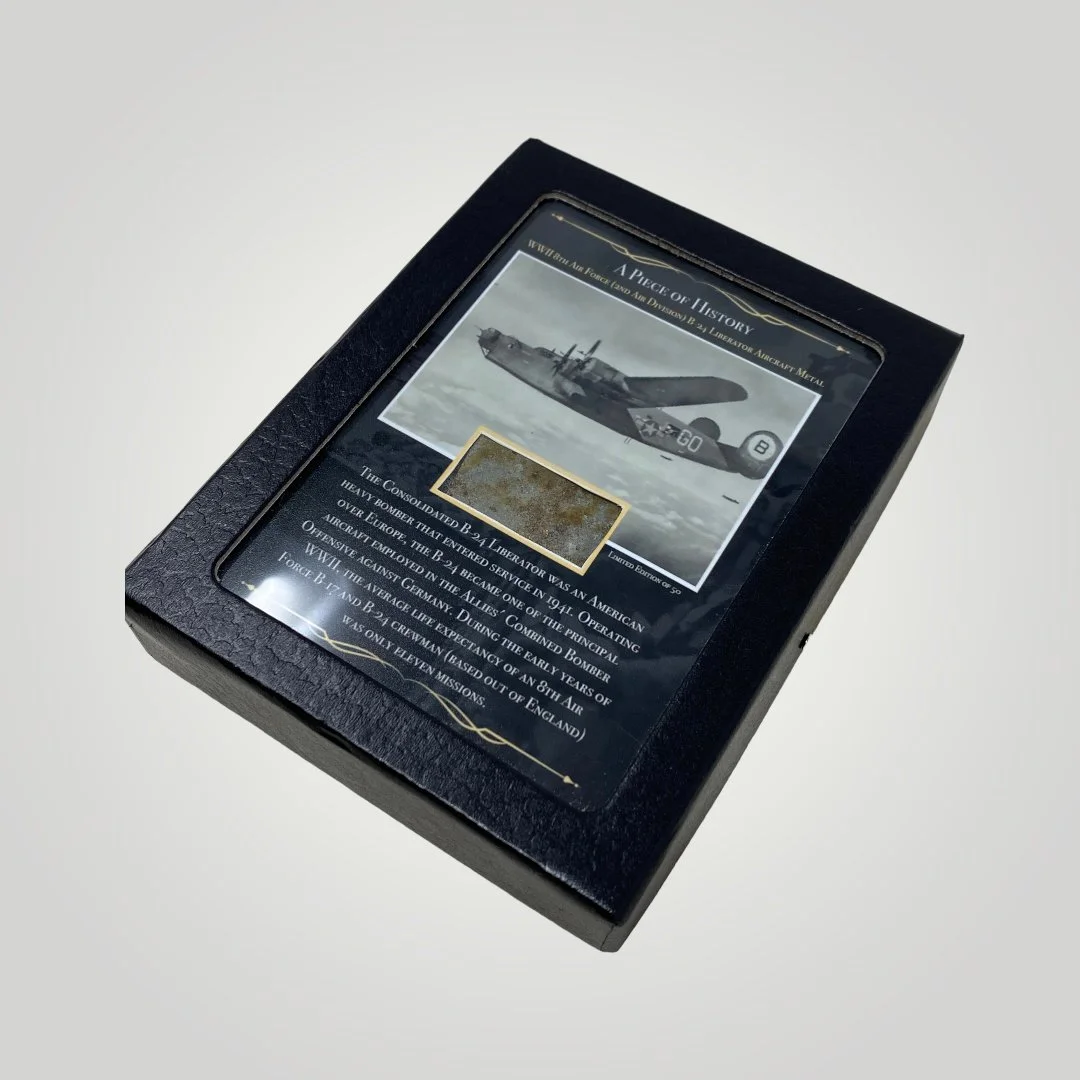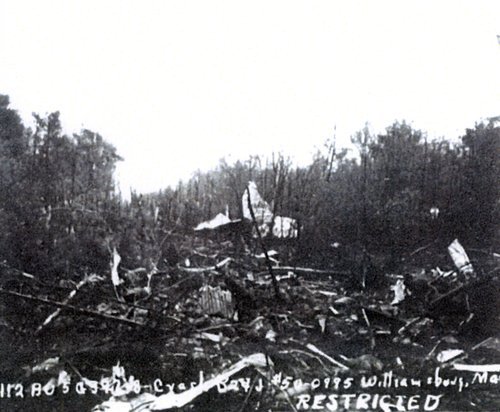RARE! WWII 8th Air Force - 2nd Air Division Consolidated B-24 Liberator Aircraft Wreckage Metal with Display Case (C.O.A. Included)


















RARE! WWII 8th Air Force - 2nd Air Division Consolidated B-24 Liberator Aircraft Wreckage Metal with Display Case (C.O.A. Included)
Comes with a hand-signed C.O.A. and a full historical research write-up.
*Limited Edition of 50*
Own your piece of history today!
Due to an incredibly high demand for display case options we are proud to offer one of our LIMITED EDITION series of HISTORIC DISPLAY CASE EXCLUSIVES. This incredible “Piece of History“ is professionally encased in a glass display case with plush padding and a tightly sealed display case. Each displays features a historical photograph and short description that corresponds to the artifact displayed. This display case measures a perfect 4.25 inches tall x 3.25 inches wide.
This series is a limited edition of 50 pieces, meaning that each “Piece of History” display is unique. The fighter pilot helmet artifact you receive may vary slightly from the display shown.
For much of 1944, the B-24 was the predominant bomber of the U.S. Strategic Air Forces (USSTAF) formerly the Eighth Air Force in the Combined Bomber Offensive against Germany, forming nearly half of its heavy bomber strength in the ETO prior to August and most of the Italian-based force. Thousands of B-24s flying from bases in Europe dropped hundreds of thousands of tons of high-explosive and incendiary bombs on German military and industrial targets.
This rare and very historic piece of WWII history is an original piece of WWII B-24 wreckage fragment recovered from Suffolk & Norfolk, England. The Suffolk and Norfolk regions of England were the main strategic airfield locations dominated by the U.S. 8th Air Force during World War II. This Consolidated B-24 Liberator heavy bomber aircraft wreckage fragment is a very rare artifact recovered from one of the 8th Air Force - 2nd Air Division (B-24s) that crash landed from post-bombing raid damage over France and Germany. The 8th Air Force - 2nd Air Division (B-24s) comprised the 44th, 93rd, 289th, 392nd, 445th, 446th, 448th, 453rd, 458th, 466th, 467th, 492nd, 489th, and 491st bomb group.
During the early years of WWII, the average life expectancy of an 8th Air Force B-17 and B-24 crewman (based out of England) was only eleven missions. This very rare B-24 wreckage artifact serves as a solemn reminder of the KIA and WIA aircrew that gave their lives to free Europe from occupied Nazi occupation.
World War II - Consolidated B-24 Liberator:
Date Introduced: 1942
Manufacturer: Consolidated-Vultee Aircraft Corporation; Ford Motor Company; North American Aviation; Douglas Aircraft Company
Number Produced: 2,698
Crew: 10 (Pilot, Co-Pilot, Bombardier, Navigator, Radio Operator, Flight Engineer, Ball Turret Gunner, Tail Gunner and two Waist Gunners)
Wingspan: 110 feet
Length: 66 feet
Maximum Speed: 303 miles per hour
Cruising Speed: 175 miles per hour
Maximum Range: 2,850 miles
Engines: Four Pratt & Whitney R-1830-43s (1,200 hp each)
Maximum Bomb Load: 8,000 pounds
Armament: Eleven .50 caliber machine guns
Full History of the 8th Air Force Consolidated B-24 Liberator:
Although the Eighth Air Force will always be associated with the B-17 Flying Fortress, the B-24 Liberator was always an important part of the Eighth’s armoury. Even at the end of the war one of the Eighth’s three Air Divisions was entirely equipped with the B-24. A total of twenty Eighth Air Force groups operated the B-24, eighteen as bomber units, one as a pathfinder group (with the B-17) and one carrying out special operations, mostly Carpetbagger missions dropping supplies and agents into occupied Europe.
It had originally been planned to move two B-24 and four B-17 units to England early in 1942. The U-boat campaign off the east coast of the United States delayed the movement of the two B-24 units, the 44th and 93rd Bombardment Groups. The 93rd finally reached Alconbury in September 1942, soon followed by the 44th. They flew their first missions on 9 October (93rd) and 7 November (44th), but after a short time in England both units were detached from the Eighth Air Force and sent to North Africa. The 93rd was first, with two of its squadrons moving to North Africa in November 1943 to support Operation Torch, effectively leaving only one B-24 unit operating from England.
During the first part of 1943 the Eighth Air Force concentrated on attacking targets in France, with the B-24 making up a small but still significant part of the forces involved. The B-24 suffered from its low numbers, being forced to fly at the slower speed of the B-17, negating one of the Liberator’s potential advantages in the dangerous skies over Europe.
In the summer of 1943 a third B-24 unit, the 389th Bombardment Group, joined the Eighth Air Force in England, but almost immediately all three Liberator units were detached from the Eighth Air Force for another spell in North Africa. This time their main target was the Romanian oil refineries at Ploesti. Operation Tidalwave, the low level attack on Ploesti, took place on 1 August 1943, and despite heavy losses was seen as a success, destroying roughly 40% of the production capacity at Ploesti, although only for a short period. The three Eighth Air Force groups were joined by two already in North Africa for this raid. While in North Africa they also carried out a number of missions to support the fighting on Sicily. The same three units would return to North Africa one final time in September 1944 to support the Allied troops fighting at Salerno.
This period saw a dramatic increase in the number of B-24 groups in the Eighth Air Force. Seven arrived in 1943 and ten in 1944, and to a great extent the story of the B-24 with the Eighth Air Force becomes the same as the story of the strategic bombing campaign. The B-24 took part in the operations of Big Week (20-25 February 1944), the attack on the German aircraft industry, the first major attack on Berlin on 6 March (which saw the loss of 16 B-24s from the 2nd Air Division) and the attack on the German oil industry, as well as the major of other elements of the strategic air campaign.
The growth in the number of B-24 groups ended in the summer of 1944. At that point the aircraft equipped the 2nd Air Division and part of the 3rd Air Division. The B-17 and B-24 did not operate well together, with different cruising speeds and operating heights, and so it was decided to convert the B-24 groups in the 3rd Air Division to the B-17. The 34th, 486th, 487th, 490th and 493rd Bombardment Groups all made the switch to the B-17 at this time.
Despite this the Liberator still equipped more Eighth Air Force bombardment groups at the end of the year than at the beginning. Of the five groups that converted to the B-17, only one, the 34th BG, had begun B-24 operations before 1944. The other four had only begun B-24 operations in April or May 1944. Another five B-24 groups began operations during 1944 and retained the aircraft to the end of the war. In April 1945 the B-24 still equipped rough one third of the Eighth Air Force’s heavy bomber groups.
The heavy bombers of the Eighth Air Force were diverted from the strategic bombing offensive on a number of occasions during 1944 and 1945. The first came in the weeks before the D-Day landings, when the heavy bombers attacked the German transport network in France, to slow down the speed with which reinforcements could be moved to Normandy. On D-Day itself both the B-24 and B-17 were used to attack German fortifications on the Normandy coast, as well as troop concentrations behind the beachhead.
The heavy bombers were also used in the fighting that followed the D-Day landings. They were used to support the British and Canadians at Caen, the Americans at Brest, and in July to attack the German lines at St Lo before the final breakout from the Normandy beach head.
By September the Allied armies were advancing at great speed across France, and were beginning to outrun their supplies. The Eighth Air Force’s B-24s were pressed into service as fuel tankers, flying much needed supplies to the advancing tank units of General Patton’s Third Army, and helping to keep up the momentum of the advance.
In December 1944 the Germans launched their last major counterattack in the west, beginning the Battle of the Bulge (December 1944-January 1945). Once the weather cleared the B-24 units were used to attack German fortifications, communication links, supply depots and even troop concentrations, playing an important role in stopping the German advance.
They were called on to aid the troops again in March 1945, this time during the crossing of the Rhine. B-24s were used to attack German troops, fortifications and supply lines, and to drop supplies to the airborne troops that had crossed the Rhine. By this point the strategic bombing campaign was beginning to wind down, as it ran out of targets, and in April the B-24s were increasingly used to support the armies. Most of the B-24 bombardment groups flew their last combat missions on 25 April 1945. In the weeks after the war the B-24 was used to ferry supplies into Holland and to return POWs from Germany and Austria.